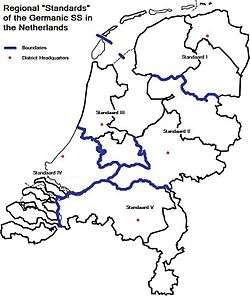Nederlandsche SS

The Nederlandsche SS (Dutch SS) was formed on September 11, 1940. On November 1, 1942 the name was changed to Germaansche SS in Nederland (Germanic SS in the Netherlands). The Nederlandsche SS in total counted about 7,000 members and was primarily a political formation. In addition it served as a reservoir for the Waffen-SS. They dressed in black uniforms that were based on those of the German SS.
History
In a meeting on June 9, 1940 between A.A. Mussert and Gottlob Berger of the German SS-Amt, Mussert was ordered by Hitler to recruit Dutch men for the Wiking division of the Waffen-SS. The Dutch volunteers would get their own regiment, the Standarte 'Westland'.
There were four reasons why the formation of extension of Himmler's SS in the Netherlands was important. First, the SS wished, as a result of Himmler's desire for expansion, to take an important position in the conquered countries. Second, the SS thought it to be of great importance for the recruitment of volunteers for the Waffen-SS. The Nederlandsche SS could not only serve as a pool of reserves, but also had an important task for creating a foundation from which future recruitment could take place. Third, the Nederlandsche SS served to push Mussert in the desired direction of a Greater Germanic Reich. Finally, the formation of a Nederlandsche SS was of great propaganda value.
At first Mussert refused to cooperate, but he had to make concessions to the German authorities to retain his own position. Despite his failure to cooperate and even advising NSB members not to serve in the SS, the unit was still established. The Germans got fed up with his half-hearted attitude and threatened to advance Meinoud Rost van Tonningen to his position, forcing Mussert to agree with the formation of the Nederlandsche SS, as a variant of the Allgemeine SS.
On September 11, 1940 the Dutch SS was formed by Mussert, formally as Afdeling XI (Department XI) of the Nationaal-Socialistische Beweging (National Socialist Movement, the NSB) making Mussert the theoretical leader of the department. Henk Feldmeijer, a protégé of Meinoud Rost van Tonningen was appointed "Voorman". In practice, Feldmeijer reported to Rauter and Heinrich Himmler, completely bypassing Mussert and his NSB. Feldmeijer sought more and more integration with the German Allgemeine SS. A training school was opened for the Dutch SS at the Avegoor estate in Ellecom in the Spring of 1941.
On 1 November 1942 the name was changed to Germaansche SS in Nederland (Germanic SS in the Netherlands). This change emphasized that it was the Greater German aspect rather than the Dutch - that was of greater importance.
By the end of 1944 the Germaansche SS in Nederland only existed on paper, thanks to the changing tide against the Germans and their supporters as the war drew to a close.
Application requirements
As the Nederlandsche SS was supposed to be an elite corps, not everybody was allowed to become a member. There were selections based on race, attitude to life, personality and physical condition. To become a member, the candidate (SS-maat, a translation of the German SS-Anwärter) had to satisfy the following conditions:
- Aryan descent proven to the year 1800 (1750 for the officers). The candidate had to give his word of honour that he knew nothing of any non-Aryan ancestors.
- No dishonorable criminal convictions.
- At least 1.72 m in height.
- Physically healthy, confirmed by medical examination.
- Age 18-30. Exceptions were made for those who were true national socialists before May 9, 1940.
- Pledge of unconditional loyalty to all superiors.
A thorough series of physical and genealogical examinations and investigations were made on each applicant. Only after these were successfully concluded did the candidate officially become an SS-Man.
Organization

The Nederlandsche SS was divided into five regional districts called "standards":[1]
- Standaard I (Friesland, Groningen and Drenthe) headquarters in Groningen.
- Standaard II (Overijssel and Gelderland) headquarters in Arnhem.
- Standaard III (Noord-Holland and Utrecht) headquarters in Amsterdam.
- Standaard IV (Zuid-Holland and Zeeland) headquarters in Den Haag.
- Standaard V (Noord-Brabant and Limburg) headquarters in Eindhoven.
There was also a separate police "standaard". The "standaarden" (plural) were in turn divided into groups (4 men), troops (40 men + leader), storms (123 men + commander + deputy) and three storm units (500 men + staff). This incorporation only existed on paper. In practice the standards consisted of a few cadre storms. On average a standaard had only 130 men. An important reason for this low number was the continuous flow of recruits to the Waffen-SS.